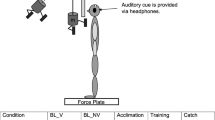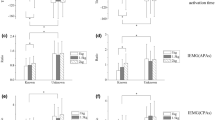Abstract
When humans are exposed to a predictable external perturbation, they usually generate anticipatory postural adjustments (APAs), which reduce the effect of potential body disturbance. However, when an external perturbation comes from behind and as such unpredicted, no APAs are generated, which challenges postural control. The aim of this study was to examine whether humans exposed to unpredictable perturbations could generate APAs using an auditory cue. Ten young adults were exposed to external perturbations hitting their shoulders from behind with or without an auditory cue prior to the physical impact. Electromyography (EMG) activities of eight trunk and leg muscles and center-of-pressure (COP) displacements were recorded and analyzed during the anticipatory and compensatory phases of postural control. Outcome measures included the latencies and integrals of muscle activities, COP displacements, and indices of co-contraction and reciprocal activation of muscles. The results showed that young adults were able to rely on an auditory cue to generate APAs prior to external perturbations coming from behind, and they demonstrated stronger APAs with training. Moreover, they utilized co-contraction of ventral and dorsal muscles as their APA response. The outcome provides a foundation for future studies aiming at using auditory cues to facilitate the generation of APAs and improve postural control in people with impaired balance while exposed to perturbations.





Similar content being viewed by others
Data availability statement
All data generated during and/or analyzed during the current study are available from the corresponding author on reasonable request.
References
Alexandrov AV, Frolov AA, Horak FB, Carlson-Kuhta P, Park S (2005) Feedback equilibrium control during human standing. Biol Cybern 93(5):309–322. https://doi.org/10.1007/s00422-005-0004-1
Aruin AS, Almeida GL (1997) A coactivation strategy in anticipatory postural adjustments in persons with down syndrome. Mot Control 1:178–191
Aruin AS, Latash ML (1996) Anticipatory postural adjustments during self-initiated perturbations of different magnitude triggered by a standard motor action. Electroencephalogr Clin Neurophysiol 101(6):497–503. https://doi.org/10.1016/s0013-4694(96)95219-4
Aruin AS, Forrest WR, Latash ML (1998) Anticipatory postural adjustments in conditions of postural instability. Electroencephalogr Clin Neurophysiol 109(4):350–359. https://doi.org/10.1016/s0924-980x(98)00029-0
Aruin AS, Shiratori T, Latash ML (2001) The role of action in postural preparation for loading and unloading in standing subjects. Exp Brain Res 138(4):458–466. https://doi.org/10.1007/s002210100729
Aruin AS, Kanekar N, Lee YJ (2015) Anticipatory and compensatory postural adjustments in individuals with multiple sclerosis in response to external perturbations. Neurosci Lett 591:182–186. https://doi.org/10.1016/j.neulet.2015.02.050
Bastian AJ (2006) Learning to predict the future: the cerebellum adapts feedforward movement control. Curr Opin Neurobiol 16(6):645–649. https://doi.org/10.1016/j.conb.2006.08.016
Bouisset S, Zattara M (1987) Biomechanical study of the programming of anticipatory postural adjustments associated with voluntary movement. J Biomech 20(8):735–742. https://doi.org/10.1016/0021-9290(87)90052-2
Chen B, Lee YJ, Aruin AS (2017) Role of point of application of perturbation in control of vertical posture. Exp Brain Res 235(11):3449–3457. https://doi.org/10.1007/s00221-017-5069-2
Crenshaw JR, Bernhardt KA, Achenbach SJ, Atkinson EJ, Khosla S, Kaufman KR, Amin S (2017) The circumstances, orientations, and impact locations of falls in community-dwelling older women. Arch Gerontol Geriatr 73:240–247. https://doi.org/10.1016/j.archger.2017.07.011
Drake JD, Callaghan JP (2006) Elimination of electrocardiogram contamination from electromyogram signals: an evaluation of currently used removal techniques. J Electromyogr Kinesiol 16(2):175–187. https://doi.org/10.1016/j.jelekin.2005.07.003
Haas G, Diener HC, Rapp H, Dichgans J (1989) Development of feedback and feedforward control of upright stance. Dev Med Child Neurol 31(4):481–488. https://doi.org/10.1111/j.1469-8749.1989.tb04026.x
Hogan N (1984) Adaptive control of mechanical impedance by coactivation of antagonist muscles. IEEE Trans Autom Control 29(8):681–690. https://doi.org/10.1109/TAC.1984.1103644
Kanekar N, Aruin AS (2014) The effect of aging on anticipatory postural control. Exp Brain Res 232(4):1127–1136. https://doi.org/10.1007/s00221-014-3822-3
Kolb FP, Lachauer S, Maschke M, Timmann D (2002) Classical conditioning of postural reflexes. Pflugers Arch Eur J Physiol 445(2):224–237. https://doi.org/10.1007/s00424-002-0892-z
Latash ML, Aruin AS, Neyman I, Nicholas JJ (1995) Anticipatory postural adjustments during self inflicted and predictable perturbations in Parkinson’s disease. J Neurol Neurosurg Psychiatry 58(3):326–334. https://doi.org/10.1136/jnnp.58.3.326
Lee YJ (2019) Changes in the symmetry of external perturbations affect patterns of muscle activity during gait initiation. Gait Posture 67:57–64. https://doi.org/10.1016/j.gaitpost.2018.09.023
Lee YJ, Chen B, Aruin AS (2015) Older adults utilize less efficient postural control when performing pushing task. J Electromyogr Kinesiol 25(6):966–972. https://doi.org/10.1016/j.jelekin.2015.09.002
Liang H, Kaewmanee T, Aruin AS (2020) The role of an auditory cue in generating anticipatory postural adjustments in response to an external perturbation. Exp Brain Res 238(3):631–641. https://doi.org/10.1007/s00221-020-05738-6
Massion J (1992) Movement, posture and equilibrium: interaction and coordination. Prog Neurobiol 38(1):35–56. https://doi.org/10.1016/0301-0082(92)90034-c
Massion J, Ioffe M, Schmitz C, Viallet F, Gantcheva R (1999) Acquisition of anticipatory postural adjustments in a bimanual load-lifting task: normal and pathological aspects. Exp Brain Res 128(1–2):229–235. https://doi.org/10.1007/s002210050842
Mochizuki G, Ivanova TD, Garland SJ (2004) Postural muscle activity during bilateral and unilateral arm movements at different speeds. Exp Brain Res 155(3):352–361. https://doi.org/10.1007/s00221-003-1732-x
Mohapatra S, Aruin AS (2013) Static and dynamic visual cues in feed-forward postural control. Exp Brain Res 224(1):25–34. https://doi.org/10.1007/s00221-012-3286-2
Mohapatra S, Krishnan V, Aruin AS (2012) The effect of decreased visual acuity on control of posture. Clin Neurophysiol 123(1):173–182. https://doi.org/10.1016/j.clinph.2011.06.008
Mohapatra S, Kukkar KK, Aruin AS (2014) Support surface related changes in feedforward and feedback control of standing posture. J Electromyogr Kinesiol 24(1):144–152
Mooney RA, Cirillo J, Byblow WD (2019) Neurophysiological mechanisms underlying motor skill learning in young and older adults. Exp Brain Res 237(9):2331–2344. https://doi.org/10.1007/s00221-019-05599-8
Nashner LM, Cordo PJ (1981) Relation of automatic postural responses and reaction-time voluntary movements of human leg muscles. Exp Brain Res 43(3–4):395–405. https://doi.org/10.1007/BF00238382
Paulignan Y, Dufosse M, Hugon M, Massion J (1989) Acquisition of co-ordination between posture and movement in a bimanual task. Exp Brain Res 77(2):337–348. https://doi.org/10.1007/BF00274991
Santos MJ, Kanekar N, Aruin AS (2010a) The role of anticipatory postural adjustments in compensatory control of posture: 1. Electromyographic analysis. J Electromyogr Kinesiol 20(3):388–397. https://doi.org/10.1016/j.jelekin.2009.06.006
Santos MJ, Kanekar N, Aruin AS (2010b) The role of anticipatory postural adjustments in compensatory control of posture: 2. Biomechanical analysis. J Electromyogr Kinesiol 20(3):398–405. https://doi.org/10.1016/j.jelekin.2010b.01.002
Selen LP, Beek PJ, van Dieën JH (2005) Can co-activation reduce kinematic variability? A simulation study. Biol Cybern 93(5):373–381. https://doi.org/10.1007/s00422-005-0015-y
Tajali S, Rouhani M, Mehravar M, Negahban H, Sadati E, Oskouei AE (2018) Effects of external perturbations on anticipatory and compensatory postural adjustments in patients with multiple sclerosis and a fall history. Int J MS Care 20(4):164–172. https://doi.org/10.7224/1537-2073.2016-098
van der Fits IB, Klip AW, van Eykern LA, Hadders-Algra M (1998) Postural adjustments accompanying fast pointing movements in standing, sitting and lying adults. Exp Brain Res 120(2):202–216. https://doi.org/10.1007/s002210050394
Woollacott MH, Shumway-Cook A (1990) Changes in posture control across the life span–a systems approach. Phys Ther 70(12):799–807
Zhang Z, Gao Y, Wang J (2019) Effects of vision and cognitive load on anticipatory and compensatory postural control. Hum Mov Sci 64:398–408. https://doi.org/10.1016/j.humov.2019.02.011
Zipp P (1982) Recommendations for the standardization of lead positions in surface electromyography. Eur J Appl Physiol 50(1):41–54. https://doi.org/10.1007/bf00952243
Author information
Authors and Affiliations
Corresponding author
Ethics declarations
Conflict of interest
All authors certify that they have no affiliations with or involvement in any organization or entity with any financial interest or non-financial interest in the subject matter or materials discussed in this manuscript.
Additional information
Communicated by Bill J Yates.
Publisher's Note
Springer Nature remains neutral with regard to jurisdictional claims in published maps and institutional affiliations.
Rights and permissions
Springer Nature or its licensor (e.g. a society or other partner) holds exclusive rights to this article under a publishing agreement with the author(s) or other rightsholder(s); author self-archiving of the accepted manuscript version of this article is solely governed by the terms of such publishing agreement and applicable law.
About this article
Cite this article
Liang, H., Kaewmanee, T. & Aruin, A.S. The feasibility of using an auditory cue to elicit anticipatory postural adjustments for a posterior perturbation. Exp Brain Res 241, 289–299 (2023). https://doi.org/10.1007/s00221-022-06520-6
Received:
Accepted:
Published:
Issue Date:
DOI: https://doi.org/10.1007/s00221-022-06520-6




